Evaluation of the Effect of a Spray Coating Applied on Open-Air-Stored Woodchips
Abstract
1. Introduction
- -
- To quantify the protection capacity against rainfall for uncovered piles of dry and fresh woody biomass in winter Mediterranean conditions, typically characterized by high intense rainfall and relatively high temperatures, factors leading to high biomass losses due to microbial degradation;
- -
- To determine the possible benefits in terms of heating value increase or preservation after the storage period provided by a coating application feasible in common biomass yard management.
2. Material and Methods
2.1. Woodchips Piles
- -
- Two piles (Pile 1 and Pile 2) were built with the fresh biomass delivered within the routinely fuel procurement of the facility. The wood material was a mix of conifers (Pinus spp.) and broadleaves (Quercus spp. and Castanea sativa Mill.). To minimize the differences between the piles, three pairs of loads from the same site and contractor were selected among the daily arrivals.
- -
- Two piles (Pile 3 and Pile 4) were prepared with dry wood chips from the facility’s roofed fuel storage. This biomass was composed of a similar mix of conifer and broadleaves material, delivered as fresh wood chips in July–August 2020 and stored for 4–5 months.
2.2. Sampling of Stored Biomass
- EC = energy content expressed as MJ t−1;
- MC = average moisture content of the pile expressed as a percentage on a wet basis;
- Weight = weight of the pile expressed in t;
- The values 18.5 and 2.44 are, respectively, the calorific value of 1 kg of dry wood and the energy required to evaporate 1 kg of water, both expressed in MJ.
2.3. Moisture Content Measurement
2.4. Statistical Analysis
3. Results
3.1. Initial Moisture Content
3.2. Temperature and Weather Conditions
3.3. Moisture and Energy Content Evolution with Storage
4. Discussion
- -
- In wet material, the results suggest that the protective film slightly reduced the moisture dispersal from the pile from evaporation rather than limit water intake from rain;
- -
- Dry material confirms the inability of the coating agent to limit water intake from rainfall. This is probably due to the water runoff, which facilitates the transit on porous areas among the wood chips where the water can cross the surface and soak the outer layers of the pile.
5. Conclusions
Author Contributions
Funding
Data Availability Statement
Conflicts of Interest
References
- Dossa, G.G.O.; Schaefer, D.; Zhang, J.-L.; Tao, J.-P.; Cao, K.-F.; Corlett, R.T.; Cunningham, A.B.; Xu, J.-C.; Cornelissen, J.H.C.; Harrison, R.D. The Cover Uncovered: Bark Control over Wood Decomposition. J. Ecol. 2018, 106, 2147–2160. [Google Scholar] [CrossRef]
- Kärhä, K. Industrial Supply Chains and Production Machinery of Forest Chips in Finland. Biomass Bioenergy 2011, 35, 3404–3413. [Google Scholar] [CrossRef]
- Whittaker, C.; Yates, N.E.; Powers, S.J.; Misselbrook, T.; Shield, I. Dry Matter Losses and Greenhouse Gas Emissions From Outside Storage of Short Rotation Coppice Willow Chip. Bioenergy Res. 2016, 9, 288–302. [Google Scholar] [CrossRef] [PubMed]
- Noll, M.; Jirjis, R. Microbial Communities in Large-Scale Wood Piles and Their Effects on Wood Quality and the Environment. Appl. Microbiol. Biotechnol. 2012, 95, 551–563. [Google Scholar] [CrossRef] [PubMed]
- Ferrero, F.; Malow, M.; Noll, M. Temperature and Gas Evolution during Large Scale Outside Storage of Wood Chips. Eur. J. Wood Prod. 2011, 69, 587–595. [Google Scholar] [CrossRef]
- Krigstin, S.; Wetzel, S. A Review of Mechanisms Responsible for Changes to Stored Woody Biomass Fuels. Fuel 2016, 175, 75–86. [Google Scholar] [CrossRef]
- Whittaker, C.; Yates, N.E.; Powers, S.J.; Misselbrook, T.; Shield, I. Dry Matter Losses and Quality Changes during Short Rotation Coppice Willow Storage in Chip or Rod Form. Biomass Bioenergy 2018, 112, 29–36. [Google Scholar] [CrossRef]
- Pecenka, R.; Lenz, H.; Idler, C. Influence of the Chip Format on the Development of Mass Loss, Moisture Content and Chemical Composition of Poplar Chips during Storage and Drying in Open-Air Piles. Biomass Bioenergy 2018, 116, 140–150. [Google Scholar] [CrossRef]
- Hofmann, N.; Mendel, T.; Schulmeyer, F.; Kuptz, D.; Borchert, H.; Hartmann, H. Drying Effects and Dry Matter Losses during Seasonal Storage of Spruce Wood Chips under Practical Conditions. Biomass Bioenergy 2018, 111, 196–205. [Google Scholar] [CrossRef]
- Afzal, M.T.; Bedane, A.H.; Sokhansanj, S.; Mahmood, W. Storage of Comminuted and Uncomminuted Forest Biomass and Its Effect on Fuel Quality. BioResources 2010, 5, 55–69. [Google Scholar] [CrossRef]
- Sahoo, K.; Bilek, E.M.; Mani, S. Techno-Economic and Environmental Assessments of Storing Woodchips and Pellets for Bioenergy Applications. Renew. Sustain. Energy Rev. 2018, 98, 27–39. [Google Scholar] [CrossRef]
- Epshtein, S.; Gavrilova, D.; Kossovich, E.; Nesterova, V.; Nikitina, I.; Fedorov, S. Technologies of Coatings Employment for Coals Oxidation Resistance Improvement. AIMS Energy 2019, 7, 20–30. [Google Scholar] [CrossRef]
- Zhou, G.; Fan, T.; Ma, Y. Preparation and Chemical Characterization of an Environmentally-Friendly Coal Dust. J. Chem. Technol. Biotechnol. 2017, 92, 2699–2708. [Google Scholar] [CrossRef]
- Wetzel, S.; Volpe, S.; Damianopoulos, J.; Krigstin, S. Can Biomass Quality Be Preserved through Tarping Comminuted Roadside Biomass Piles? Forests 2017, 8, 305. [Google Scholar] [CrossRef]
- Anerud, E.; Bergström, D.; Routa, J.; Eliasson, L. Fuel Quality and Dry Matter Losses of Stored Wood Chips-Influence of Cover Material. Biomass Bioenergy 2021, 150, 106109. [Google Scholar] [CrossRef]
- Sahoo, K.; Mani, S. Techno-Economic Assessment of Biomass Bales Storage Systems for a Large-Scale Biorefinery. Biofuels Bioprod. Biorefining 2017, 11, 417–429. [Google Scholar] [CrossRef]
- Heinek, S.; Polanz, S.; Huber, M.; Hofmann, A.; Monthaler, G.; Fuchs, H.; Larch, C.; Giovannini, A. Biomass Conditioning: Degradation of Biomass during the Storage of Woodchips. In Proceedings of the 21st European Biomass Conference and Exhibition, Copenhagen, Denmark, 3–7 June 2013; ETA-Florence: Copenhagen, Denmark, 2013; Volume 2, pp. 147–150. [Google Scholar]
- Lenz, H.; Pecenka, R.; Idler, C.; Dumfort, S.; Whittaker, C.; Ammon, C.; Hartung, E. Continuous Weighing of a Pile of Poplar Wood Chips—A Comparison of Methods to Determine the Dry Matter Losses during Storage. Biomass Bioenergy 2017, 96, 119–129. [Google Scholar] [CrossRef]
- ISO 18134-1:2022; Solid Biofuels, Determination of Moisture Content, Oven Dry Method. Part 1: Total Moisture Reference Method. International Organization for Standardization: Geneva, Switzerland, 2022.
- Jirjis, R. Effects of Particle Size and Pile Height on Storage and Fuel Quality of Comminuted Salix Viminalis. Biomass Bioenergy 2005, 28, 193–201. [Google Scholar] [CrossRef]
- Thornqvist, T. Drying and Storage of Forest Residues for Energy Production. Biomass 1985, 7, 125–134. [Google Scholar] [CrossRef]
- Lenz, H.; Idler, C.; Hartung, E.; Pecenka, R. Open-Air Storage of Fine and Coarse Wood Chips of Poplar from Short Rotation Coppice in Covered Piles. Biomass Bioenergy 2015, 83, 269–277. [Google Scholar] [CrossRef]
- Kuptz, D.; Lesche, S.; Mendel, T.; Mack, R.; Rist, E.; Schön, C.; Hartmann, H. Fuel Properties, Dry Matter Losses and Combustion Behavior of Wood Chips Stored at Aerobic and Anaerobic Conditions. Biomass Bioenergy 2020, 142, 105745. [Google Scholar] [CrossRef]
- Dumfort, S.; Kirchmair, C.; Floerl, K.; Larch, C.; Rupprich, M. Storage as the Weak Link of the Biomass Supply Chain. In Africa-EU Renewable Energy Research and Innovation Symposium 2018 (RERIS 2018); Mpholo, M., Ed.; Springer: Berlin/Heidelberg, Germany, 2018; pp. 117–125. [Google Scholar]
- Bozaghian, M.; Rebbling, A.; Larsson, S.H.; Thyrel, M.; Xiong, S.; Skoglund, N. Combustion Characteristics of Straw Stored with CaCO3 in Bubbling Fluidized Bed Using Quartz and Olivine as Bed Materials. Appl. Energy 2018, 212, 1400–1408. [Google Scholar] [CrossRef]
- Xiong, S.; Bozaghian, M.; Lestander, T.A.; Samuelsson, R.; Hellqvist, S.; Öhman, M. Calcium Oxide as an Additive for Both Conservation and Improvement of the Combustion Properties of Energy Grass: A Preliminary Study. Biomass Bioenergy 2017, 99, 1–10. [Google Scholar] [CrossRef]
- Kuptz, D.; Schreiber, K.; Schulmeyer, F.; Lesche, S.; Zeng, T.; Ahrens, F.; Zelinski, V.; Schön, C.; Pollex, A.; Borchert, H.; et al. Evaluation of Combined Screening and Drying Steps for the Improvement of the Fuel Quality of Forest Residue Wood Chips—Results from Six Case Studies. Biomass Convers. Biorefinery 2019, 9, 83–98. [Google Scholar] [CrossRef]
- Mendel, T.; Hofmann, N.; Schulmeyer, F.; Borchert, H.; Kuptz, D.; Hartmann, H. Fuel Quality Changes during the Storage of Wood Chips in Large Piles. Eur. Biomass Conf. Exhib. Proc. 2016, 2016, 53–59. [Google Scholar] [CrossRef]

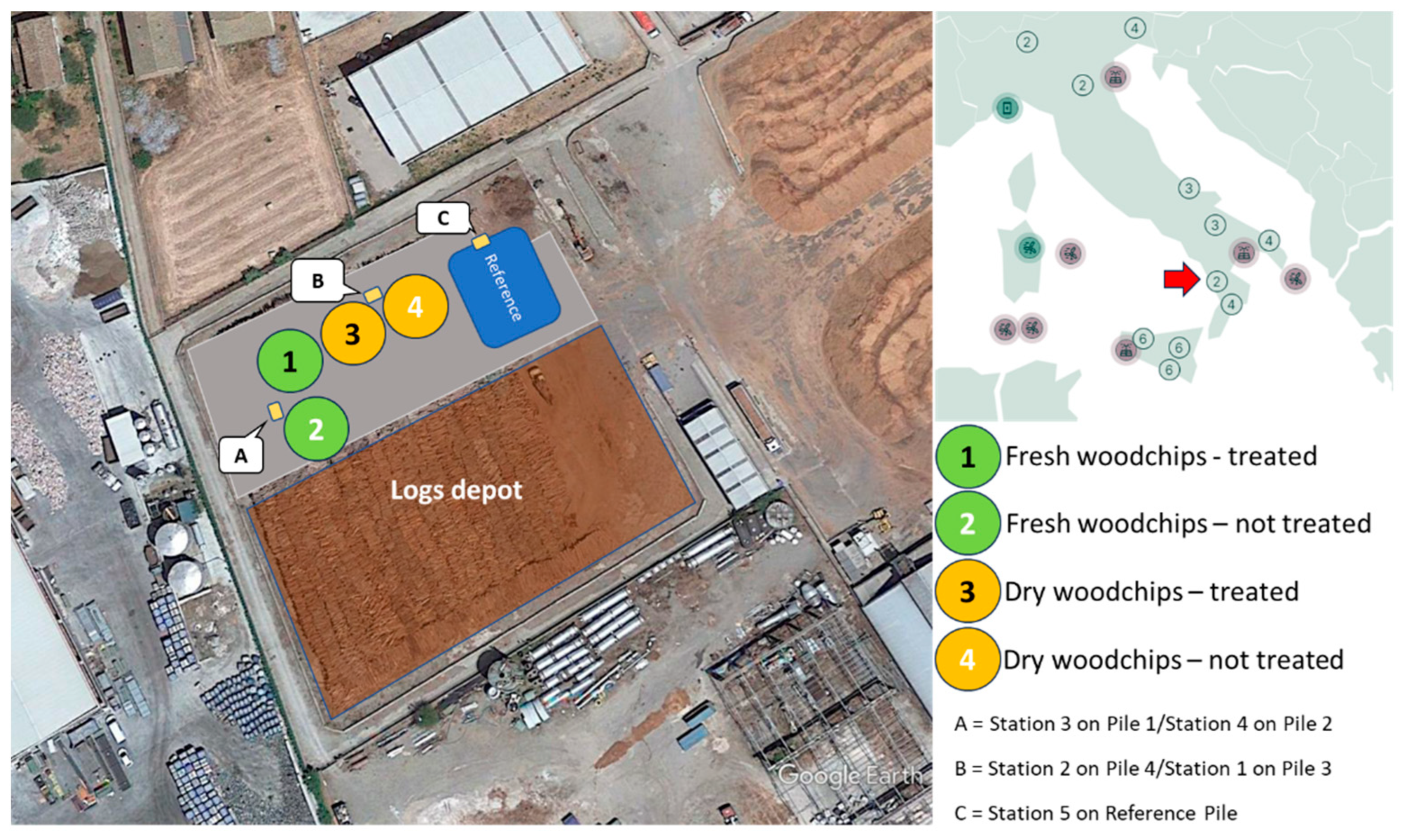

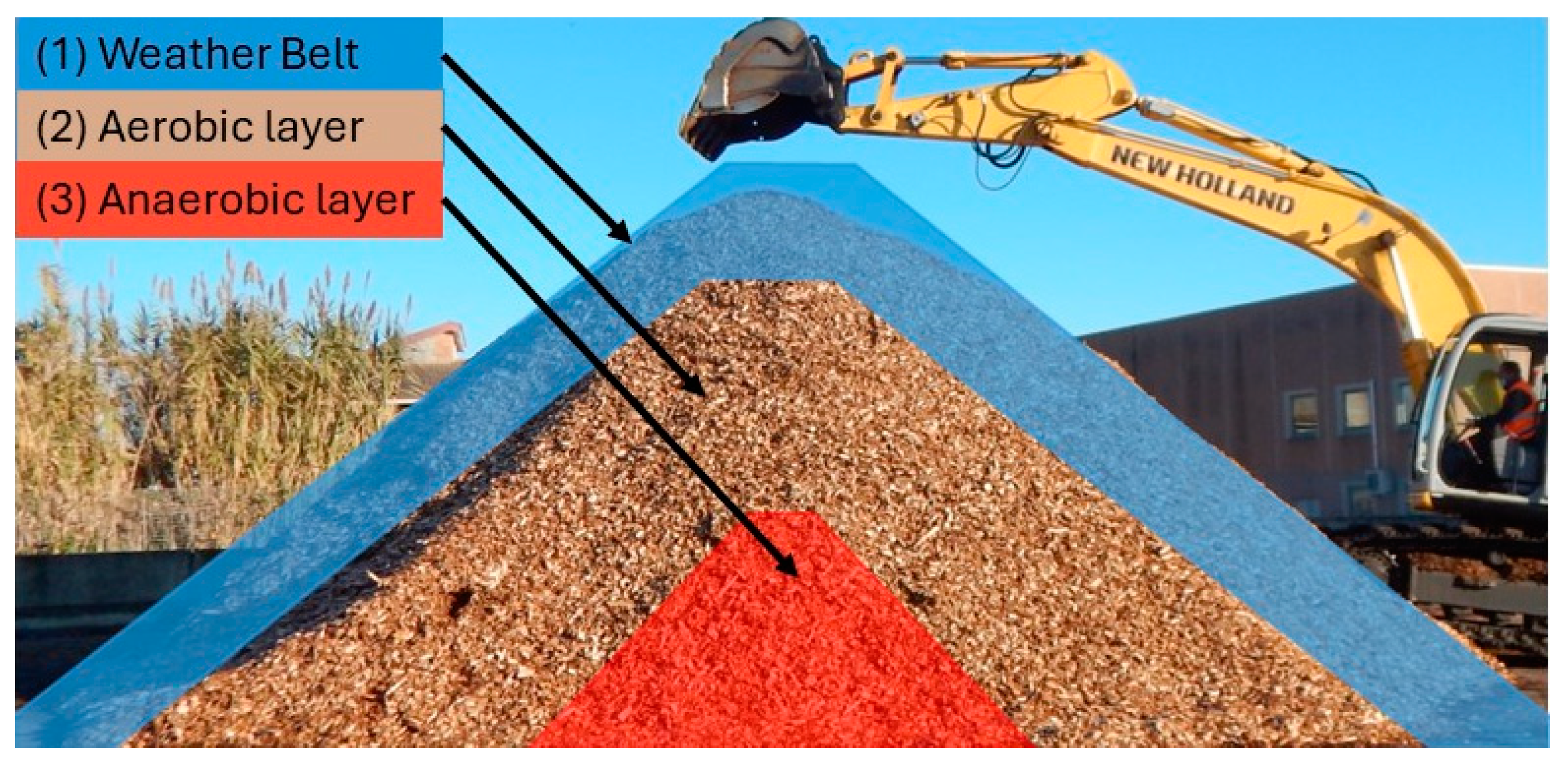
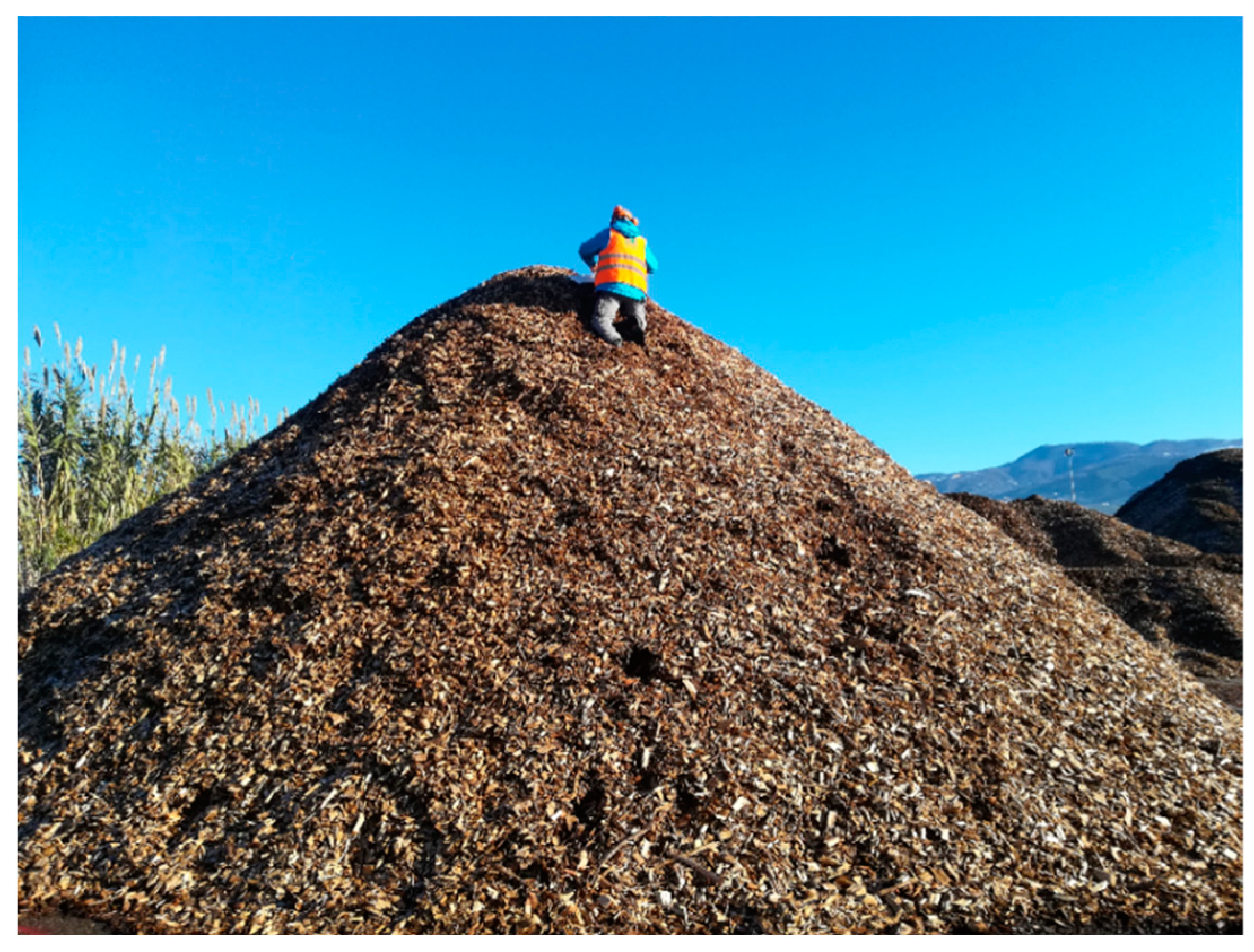
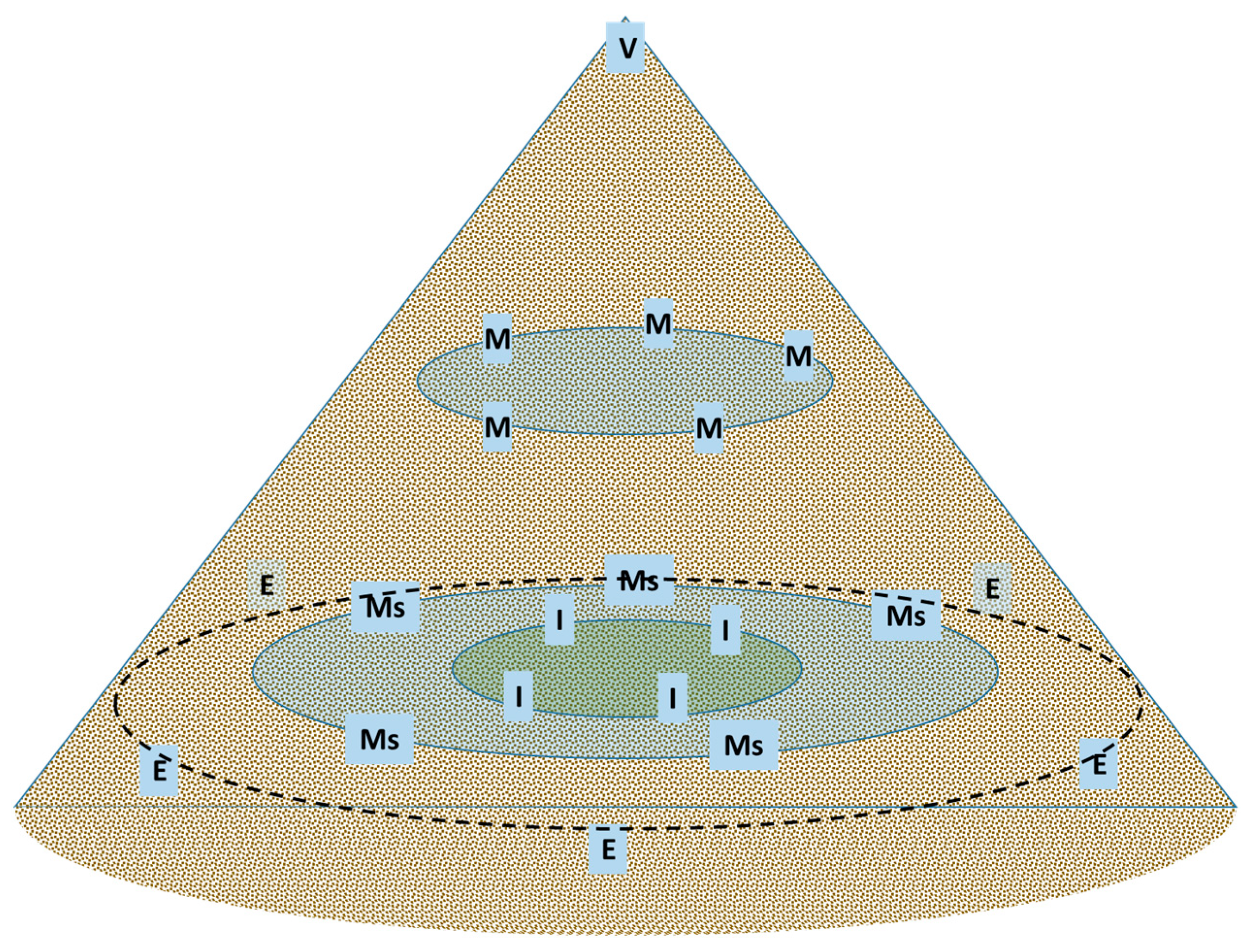
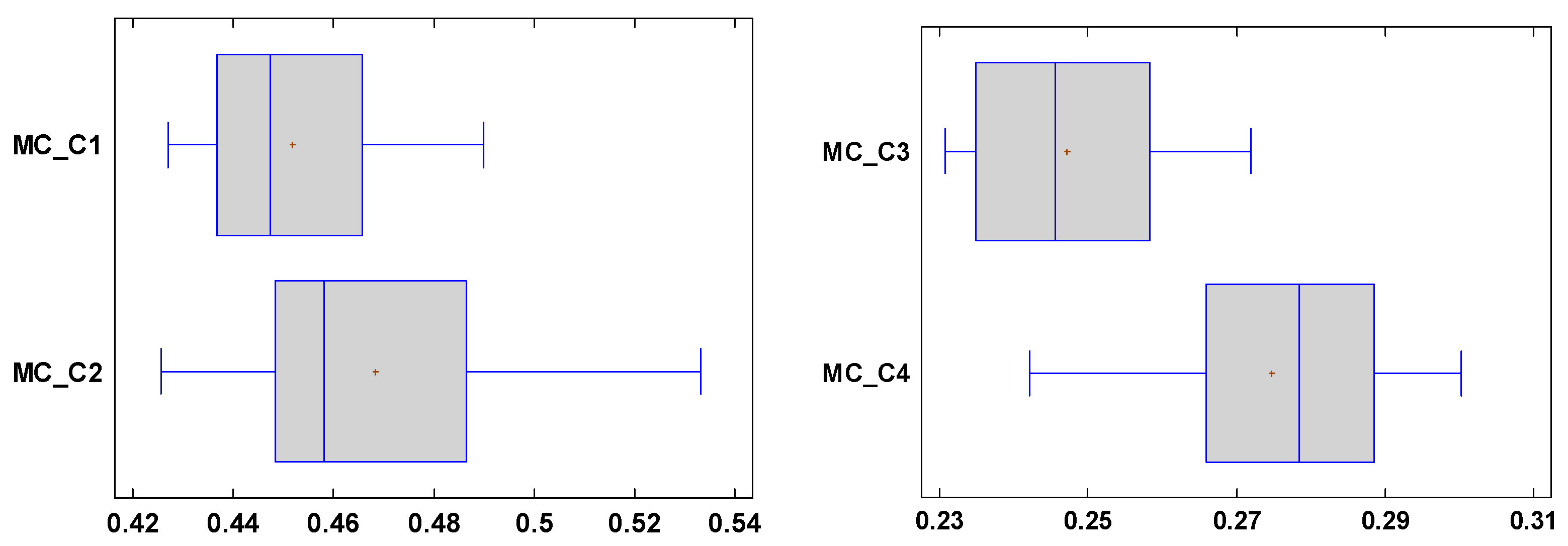
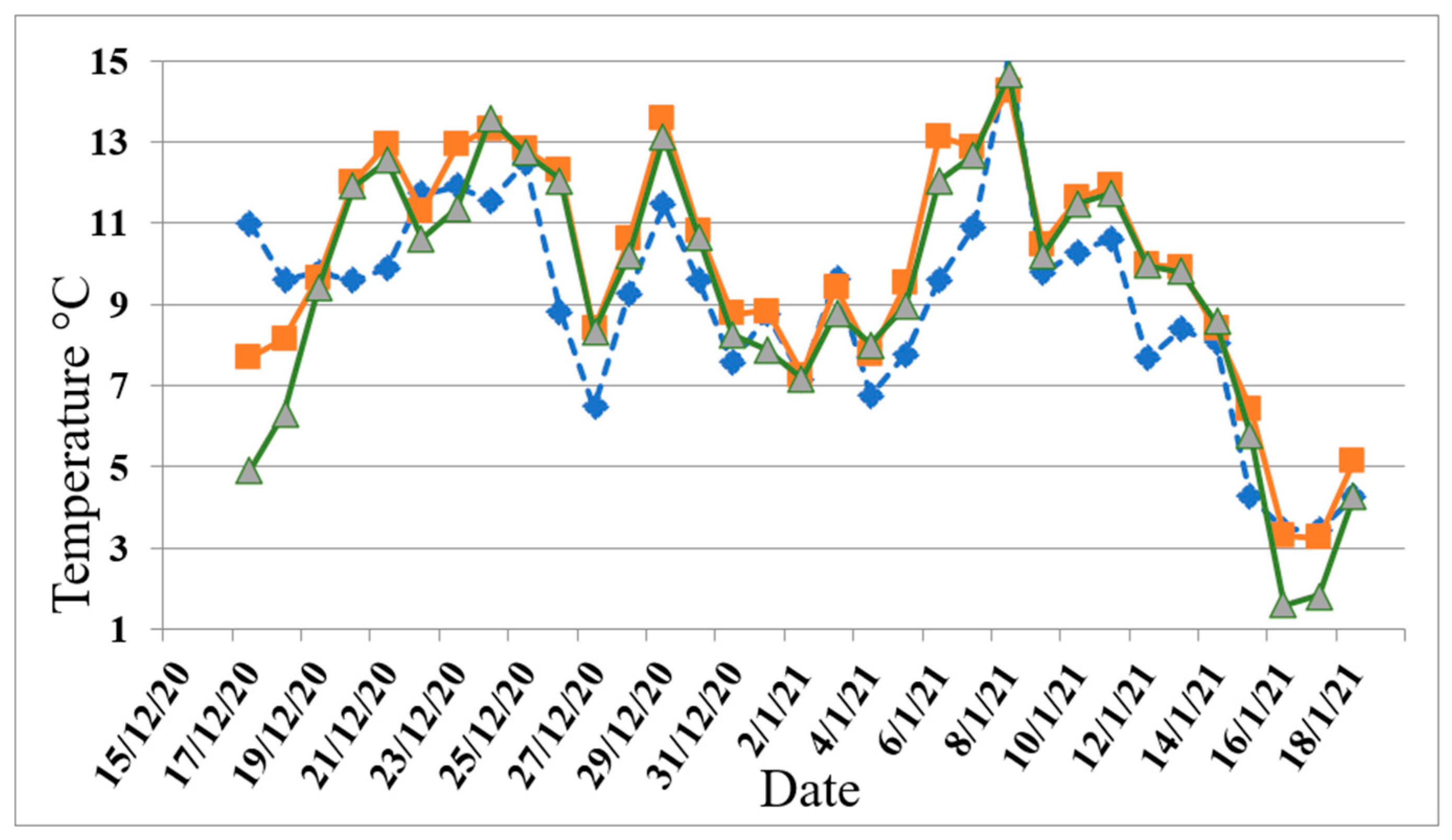
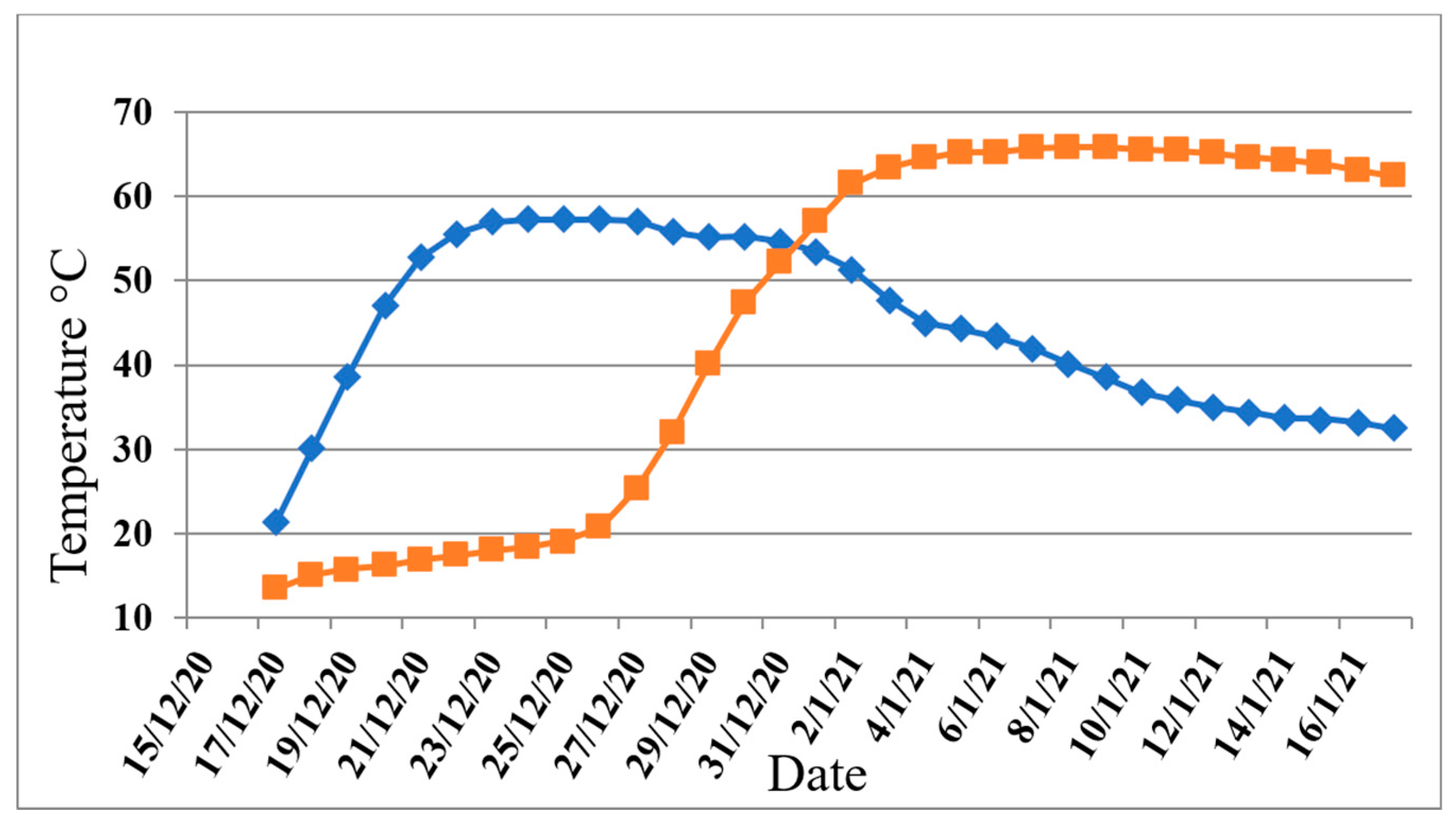
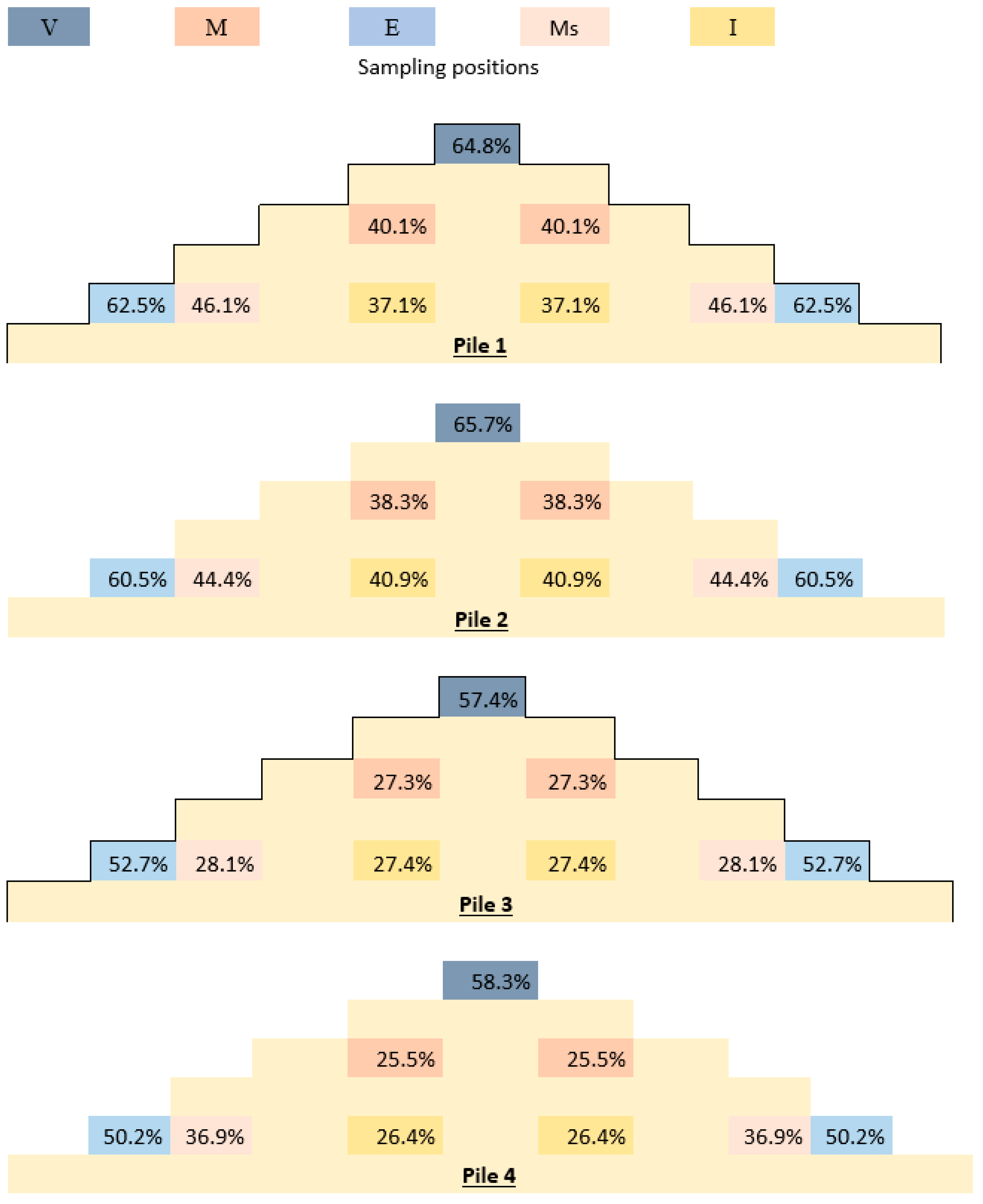
| Test | Biomass Initial Status | Coating | Average MC | SD | Max | Min | Delta |
|---|---|---|---|---|---|---|---|
| Pile 1 | Fresh | Yes | 45.2% | 1.8 | 49.0% | 42.7% | 6.3 |
| Pile 2 | Fresh | No | 46.8% | 3.4 | 53.3% | 42.6% | 10.7 |
| Pile 3 | Dry | Yes | 24.7% | 1.3 | 27.2% | 23.1% | 4.1 |
| Pile 4 | Dry | No | 27.5% | 1.8 | 30.0% | 24.2% | 5.8 |
| Pile 1 | Pile 2 | Pile 3 | Pile 4 | |
|---|---|---|---|---|
| Initial condition | Fresh | Dry | ||
| Coating treatment | yes | no | yes | no |
| Initial Moisture % | 45.2% | 46.8% | 24.7% | 27.5% |
| Final Moisture % | 45.3% | 44.9% | 34.1% | 36.5% |
| MC variation % | +0.1% | −1.9% | +9.4% | +9.1% |
| Initial Mass (t) | 96.38 | 97.52 | 65.72 | 68.8 |
| Final Mass (t) | 96.2 | 93.9 | 75.08 | 78.56 |
| Mass variation (t) | −0.18 | −3.62 | +9.36 | +9.76 |
| Initial dry matter (t) | 52.8 | 51.8 | 49.5 | 49.9 |
| Final dry matter (t) | 50.2 | 49.5 | 48.5 | 50.0 |
| Dry matter variation (t) | −2.66 | −2.34 | −0.95 | +0.12 |
| Initial energy content (MJ) | 871,132 | 847,818 | 875,550 | 877,023 |
| Final energy content (MJ) | 815,816 | 807,678 | 832,908 | 855,671 |
| Energy content variation (MJ) | −55,315 | −40,139 | −42,641 | −21,352 |
| Pile 1 | Pile 2 | Pile 3 | Pile 4 | |
|---|---|---|---|---|
| Initial condition | Fresh | Dry | ||
| Coating treatment | yes | no | yes | no |
| Initial Moisture % | 45.2% | 46.8% | 24.7% | 27.5% |
| Final Moisture % | 45.3% | 44.9% | 34.1% | 36.5% |
| MC variation % | +0.1% | −1.9% | +9.4% | +9.1% |
| Initial Mass (t) | 96.38 | 97.52 | 65.72 | 68.8 |
| Final Mass (t) | 96.2 | 93.9 | 75.08 | 78.56 |
| Mass variation (t) | −0.18 | −3.62 | +9.36 | +9.76 |
| Initial dry matter (t) | 52.8 | 51.8 | 49.5 | 49.9 |
| Final dry matter (t) | 52.6 | 51.7 | 49.5 | 49.9 |
| Dry matter variation (t) | −0.17 | −0.14 | 0 | −0.04 |
| Initial energy content (MJ) | 871,132 | 847,818 | 875,550 | 877,023 |
| Final energy content (MJ) | 867,958 | 853,634 | 852,916 | 852,382 |
| Energy content variation (MJ) | −3174 | +5815 | −22,634 | −24,641 |
Disclaimer/Publisher’s Note: The statements, opinions and data contained in all publications are solely those of the individual author(s) and contributor(s) and not of MDPI and/or the editor(s). MDPI and/or the editor(s) disclaim responsibility for any injury to people or property resulting from any ideas, methods, instructions or products referred to in the content. |
© 2024 by the authors. Licensee MDPI, Basel, Switzerland. This article is an open access article distributed under the terms and conditions of the Creative Commons Attribution (CC BY) license (https://creativecommons.org/licenses/by/4.0/).
Share and Cite
Picchi, G.; Nati, C.; Brilli, L.; Cinotti, A. Evaluation of the Effect of a Spray Coating Applied on Open-Air-Stored Woodchips. Resources 2024, 13, 58. https://doi.org/10.3390/resources13040058
Picchi G, Nati C, Brilli L, Cinotti A. Evaluation of the Effect of a Spray Coating Applied on Open-Air-Stored Woodchips. Resources. 2024; 13(4):58. https://doi.org/10.3390/resources13040058
Chicago/Turabian StylePicchi, Gianni, Carla Nati, Lorenzo Brilli, and Alessandro Cinotti. 2024. "Evaluation of the Effect of a Spray Coating Applied on Open-Air-Stored Woodchips" Resources 13, no. 4: 58. https://doi.org/10.3390/resources13040058
APA StylePicchi, G., Nati, C., Brilli, L., & Cinotti, A. (2024). Evaluation of the Effect of a Spray Coating Applied on Open-Air-Stored Woodchips. Resources, 13(4), 58. https://doi.org/10.3390/resources13040058








